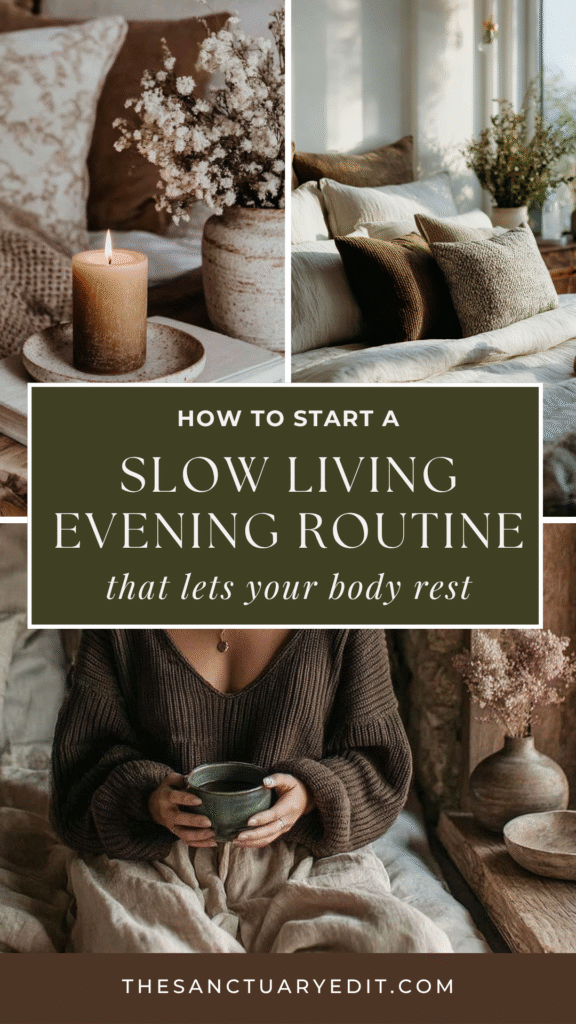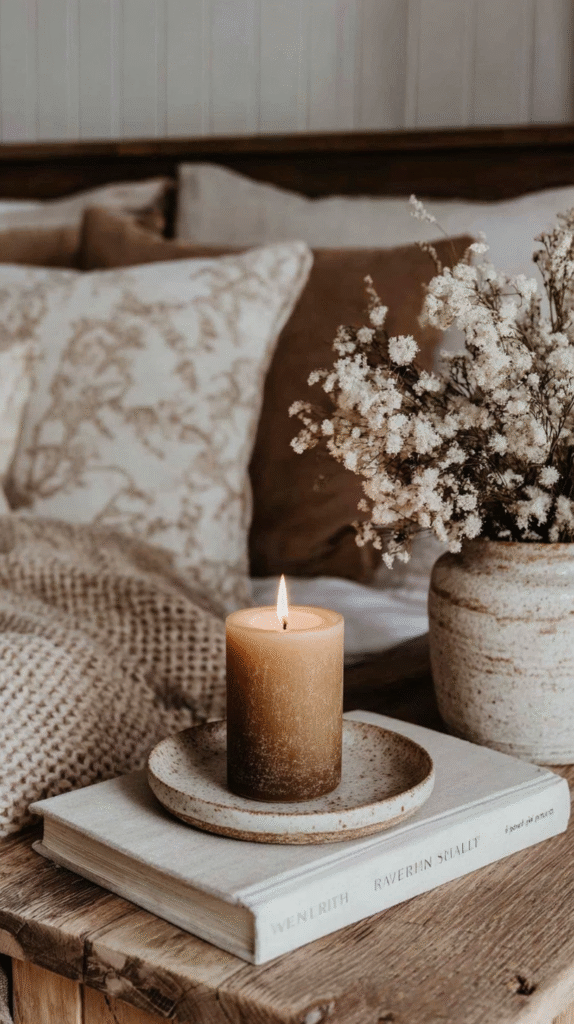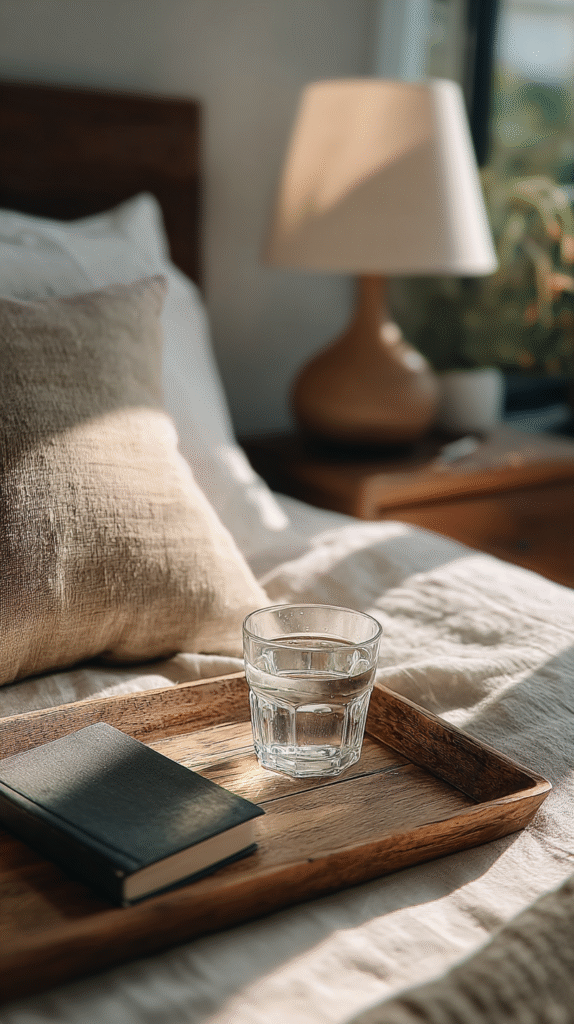This post may contain affiliate links, including those from Amazon Associates. If you make a purchase through these links, I may earn a commission at no additional cost to you. Learn more about our affiliate policy.
Some evenings feel turned up too loud. The lights are sharp, your mind keeps scrolling unfinished tasks, and your body cannot find the exhale.
You want a sanctuary, not another list that adds pressure.
Slow living starts with cues that your nervous system can recognize as safety.
If you feel overstimulated, you are not alone. Many women describe decision fatigue, clutter anxiety, and the sense that even at home they are still in fight or flight.
These routines are small and simple to integrate into your evenings. Each one teaches your body that night has arrived and rest is welcome.

Why Evening Rituals Calm an Overstimulated System
Your nervous system reads your environment all day. Bright light, screens, and noise keep you alert even when you feel tired.
A short, repeatable sequence at night helps your brain predict what comes next. Predictability reduces stress and invites parasympathetic calm.
Think of evening rituals as a soft landing instead of a hard stop. They do not need to look perfect or take an hour. What matters is consistency and sensory cues that feel real to you. The goal is to create a pattern your body trusts.
For more ways to transition your body toward rest, explore these slow living evening routines that help you fall asleep more easily.
Routine 1: Soften the Light

Light is a strong signal. About an hour before bed, turn off overhead bulbs and switch to warm lamps like a Himalayan salt lamp or a candle.
Let light fall sideways across the room so your eyes can rest. If you use screens, lower brightness and use an amber filter.
This small edit supports melatonin and gives your brain a clear message that the day is closing.
Many readers say soft light instantly eases the sense of visual chaos. If you can, use a linen shade or amber glass to add texture to the glow.
Warm light plus quiet shadows feels like exhale.
If you love creating restful corners, explore how to make a calm hygge reading corner for relaxation to extend that same mood into your evening spaces.
Routine 2: A Simple Closure Cue
When life is busy, your mind keeps searching for what is unfinished. A closure cue is a short action you repeat every night.
It might be turning on a diffuser, putting your phone in a drawer, or whispering a phrase such as enough for today. The cue marks the end of input.
Over time, this tiny ritual becomes a bridge between doing and being. It also helps with Pinterest paralysis, where you collect ideas but rarely implement.
One cue, the same way, tells your system that you can set the day down. If you share a home, invite everyone to adopt the cue together.
Routine 3: Gentle Movement To Move Stress Out
Stress often lives in shoulders, jaw, and hips. A few minutes of floor-based movement helps release that holding pattern.
Try slow neck rolls, a seated fold, a supported child’s pose, and legs up the wall for three to five minutes. Breathe slowly and feel your back supported.
This is not a workout. It is body kindness. Small, slow movement tells your system there is no threat here and that it can soften.
If decision fatigue makes you resist a sequence, choose one shape you enjoy and repeat it nightly. Familiarity is more important than variety.
Routine 4: Let Thoughts Land on Paper
When your head touches the pillow, your mind may replay conversations or worries. A short journaling ritual offloads that loop.
Set a three to five minute timer. Write what felt heavy, what felt good, and what you are willing to leave for tomorrow. Keep it simple and imperfect.
This practice is emotional hygiene, not performance. It helps your system close open tabs so your brain does not keep you alert.
If writing feels like one more task, try a tiny prompt such as three lines I am releasing tonight. Place the notebook beside your bed so the ritual is effortless.
Routine 5: Warm Water and Tactile Care
A warm shower or bath about an hour before sleep can help your body cool afterward, which signals rest.
Move slowly as you dry off. Moisturize hands and feet, brush hair with intention, or apply a calming oil at your temples. Choose one scent you use only at night so your brain pairs it with calm.
This is about sensory closure. Warmth, scent, and touch communicate safety faster than thoughts do. If you are exhausted, even washing your face with warm water and breathing for a count of four can shift your state.
Tiny and consistent beats elaborate and rare.
Build a Flow That Fits Your Life

Start with one or two practices for a week. Keep the order the same so your body learns the pattern. If you miss a night, return the next evening without judgment. Your routine can be ten minutes and still be effective.
Try this minimal flow when life feels full.
Dim a lamp, put your phone in a drawer, wash your face with warm water, then write three lines you are releasing. On evenings with more space, add gentle movement and a longer journal entry. Adjust by season and energy.
Troubleshooting Common Sticking Points
If you feel fake trying to slow down, remember that your nervous system needs repetition before something feels natural. Give your routine seven nights and observe how your body responds. Authenticity grows with practice, not with perfect props.
If the house feels chaotic, choose the one square you can control. A bedside lamp, a small tray for a journal, or a candle by the sink can become your nightly anchor.
You do not need a perfect home to rest. You need one reliable cue that meets you where you are.
If you worry you will start and never finish, reduce the scope. Two minutes of a single practice, every night, counts. When it feels stable, you can layer in more. Progress over perfection is not a slogan here. It is nervous system strategy.
Make Your Home a Partner in Sleep
Support these routines with small environmental edits. Keep your nightstand clear so your eyes have visual rest. Use breathable linens and a soft throw at the end of the bed. If outside light or noise disrupts you, try blackout curtains or a simple sound machine.
Bring in nature where you can. A small plant, a branch in a vase, or a stone on the nightstand adds grounding texture. Natural elements remind your system of slower rhythms and help ease urban overstimulation.
Closing Reflection
Evenings do not need to look like a magazine to be restorative. They only need a few consistent cues that tell your body it is safe to let go. Soft light, a simple closure ritual, a few minutes of movement, a page of writing, and a warm sensory moment are enough.
You can also draw inspiration from how to build a slow morning routine for all-day calm, creating gentle symmetry between how you open and close your days.
Your home can be your stressor or your sanctuary. Tonight, choose one signal and repeat it. With time, your body will learn the language of rest. The day will end more softly, and you will feel yourself return.


